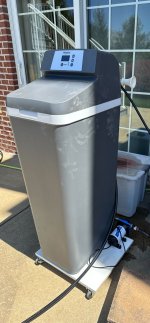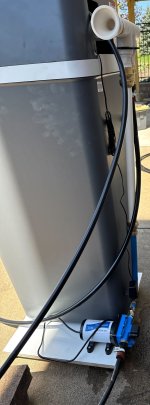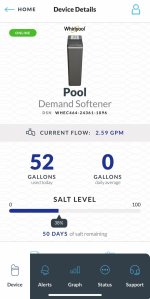I've seen a few discussions of this idea, so I thought I'd share my wacky project (mods move if I picked the wrong spot).
I have a 23k gallon in ground vinyl liner pool with a Circupool salt generator. I love it.
One of the things I love about it is the Autocover I added. It keeps my kids safe, keeps the heat in, keeps the sun off the pool, and keeps junk out of the pool. I leave it closed except when we are actually swimming.
The autocover also keeps rain out of the pool. Although this makes chemical maintenance simpler (no dilution), it also means that I have to add water from a hose to make up for evaporation.
The water from my hose is hard. Like 100+ppm hard. This means that, over time, the hardness in the pool slowly goes up. I'm over 400ppm now. I have so much calcium in the water that it precipitates out as flakes that the pool robot vacuums up.
This is probably bad for things.
The last time this happened, I did a water exchange. I was nervous about draining the pool, so I pumped water in and out at the same time from opposite ends of the pool.
This is expensive. Due to mixing, I have to pump out (and replace) far more water than I actually want to exchange. Plus, the water I am putting in is hard anyway.
My genius(???) solution was to use a water softener instead. I would get a softener, put it on a wheeled base, attach a little 5gpm pump I have, and pump all the pool water through the softener. It would replace the calcium with salt, which is fine since I can deal with another several hundred ppm of salt in the pool (that already has several thousand ppm).
Once the calcium is removed, I can keep the softener around just to pipe the hose through when I need to add water to the pool.
After a bunch of comparisons, I bought a Whirlpool WHEC46, which was $600 at Lowe's. I put it on piece of plywood, added some casters and wheeled it over to the pool. I didn't want metal fittings on the hoses running to the pool, so I used irrigation hose (which is also cheaper). Several fittings convert from the 1/2" NPT on the pump to the irrigation hose and the 1" NPT fittings on the water softener.


Plugged it in, set up the water softener, and turned on the pump. It's running!

There are still some details to work out.
My drop test this morning said 400ppm of calcium. I'll check it every day and see.
I have a 23k gallon in ground vinyl liner pool with a Circupool salt generator. I love it.
One of the things I love about it is the Autocover I added. It keeps my kids safe, keeps the heat in, keeps the sun off the pool, and keeps junk out of the pool. I leave it closed except when we are actually swimming.
The autocover also keeps rain out of the pool. Although this makes chemical maintenance simpler (no dilution), it also means that I have to add water from a hose to make up for evaporation.
The water from my hose is hard. Like 100+ppm hard. This means that, over time, the hardness in the pool slowly goes up. I'm over 400ppm now. I have so much calcium in the water that it precipitates out as flakes that the pool robot vacuums up.
This is probably bad for things.
The last time this happened, I did a water exchange. I was nervous about draining the pool, so I pumped water in and out at the same time from opposite ends of the pool.
This is expensive. Due to mixing, I have to pump out (and replace) far more water than I actually want to exchange. Plus, the water I am putting in is hard anyway.
My genius(???) solution was to use a water softener instead. I would get a softener, put it on a wheeled base, attach a little 5gpm pump I have, and pump all the pool water through the softener. It would replace the calcium with salt, which is fine since I can deal with another several hundred ppm of salt in the pool (that already has several thousand ppm).
Once the calcium is removed, I can keep the softener around just to pipe the hose through when I need to add water to the pool.
After a bunch of comparisons, I bought a Whirlpool WHEC46, which was $600 at Lowe's. I put it on piece of plywood, added some casters and wheeled it over to the pool. I didn't want metal fittings on the hoses running to the pool, so I used irrigation hose (which is also cheaper). Several fittings convert from the 1/2" NPT on the pump to the irrigation hose and the 1" NPT fittings on the water softener.


Plugged it in, set up the water softener, and turned on the pump. It's running!

There are still some details to work out.
- I need a longer drain hose so that the softener can live under my deck (which has a "ceiling" with a water collection system) -- this will keep the rain and (most of) the sun off of it.
- I will eventually need to see about winterizing the unit.
- I'm doing this at the start of the year since I read that chlorine can damage the resin beads... but there's still 7ppm of chlorine in the pool (I guess I overdid my boost at the end of the year).
My drop test this morning said 400ppm of calcium. I'll check it every day and see.

